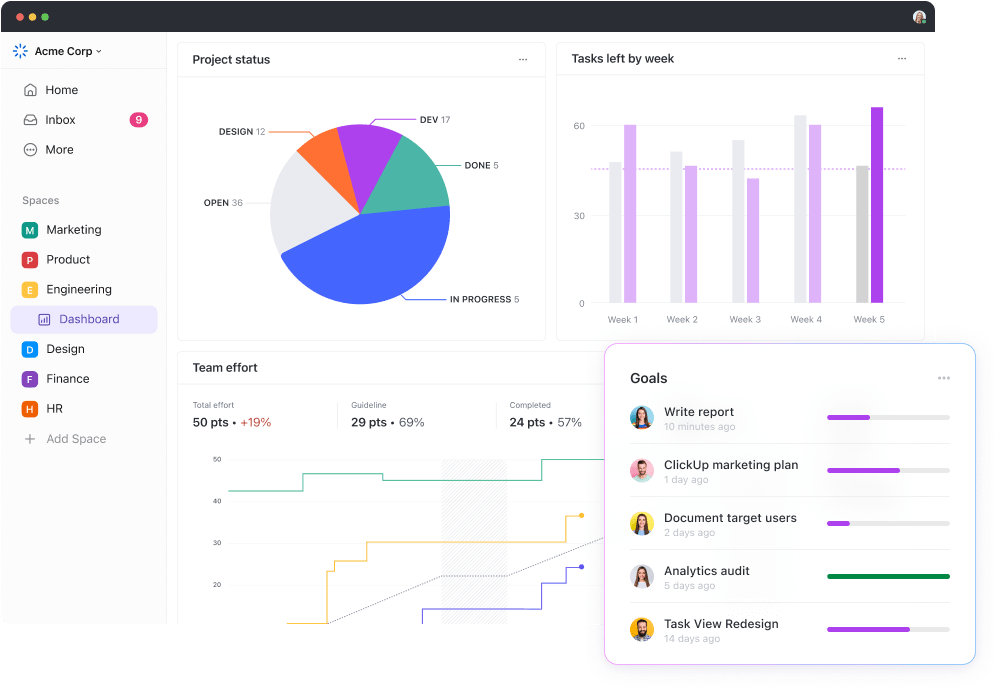Most meetings could easily be emails. According to McKinsey, about 61% of executives think this way. Yes, sixty-one.
And it gets worse. Poorly designed meetings are driving 80% of executives to rethink or already change their meeting structures and schedules in an era of remote work.
As virtual meetings became the default, they multiplied unnecessarily—spreading faster than bad Wi-Fi on a Zoom call.
So, what’s the antidote to this meeting mayhem? Setting clear meeting ground rules.
We’ve rounded up the top 13 rules every successful meeting needs to help you start.
⏰ 60-Second Summary
Want to have purposeful meetings that improve team communication? Here are our best tips:
- Set clear ground rules: Define the purpose, keep meetings small, and ensure everyone participates actively for focused and productive discussions
- Plan effectively: Schedule meetings at least four hours in advance, minimize distractions to stay present, and record notes and action items with tools like Docs
- Foster inclusivity and collaboration: Create an environment of equality and respect, ensuring all voices are heard, and key takeaways are shared promptly using Chat
- Optimize meeting frequency: Regularly reassess recurring meetings, track goals with Dashboards, and focus on solutions rather than blame
- Respect time: Stick to the schedule, end meetings early if possible, and establish no-meeting days to recharge and boost team productivity
Top 13 Meeting Rules for Better Team Communication
Why Are Meeting Rules Important?
How would you like the following changes in your lifestyle?
- Save time
- Eliminate unnecessary discussions
- Focus on critical goals
- Make quicker decisions
- Have clear actions and priorities
- Feel less drained
That’s exactly what meeting ground rules bring to the table.
Setting clear meeting rules ensures everyone stays on track, discussions remain productive, and decisions don’t spiral into endless loops of debate.
Teams with well-defined ground rules can achieve up to 30% more efficiency because they spend less time on meaningless chatter and more on actionable tasks.
Rules like “everyone contributes” encourage inclusivity, ensuring that even quieter voices in the room or on Zoom are heard. This creates a more balanced and diverse environment where fresh ideas can truly flourish.
🍪 Bonus: The most important rule is probably setting a clear meeting agenda. This gives everyone a roadmap of what’s to come. When participants are prepared, conversations stay on topic and on time, so chats about last night’s soccer game can be postponed to the water cooler catch-ups.
Top 13 Ground Rules for Successful Meetings
Let’s start from the top: here are 13 meeting ground rules that will make your life a little easier.
💡 Pro Tip: Create a meeting checklist that includes agendas, action items, and follow-ups to stay organized.
1. Define the meeting purpose
Every meeting should start with the big question: Why are we here? If no one can answer that, the meeting should be canceled to spare everyone the misery.
A clearly defined purpose directs the discussion and ensures everyone comes prepared with relevant questions and ideas.
Defining the purpose also helps participants focus on the big picture, reducing common meeting pitfalls like distractions. Communicating the purpose beforehand ensures that everyone enters the room (or the virtual call) positively and is ready to contribute to productive meetings.
Managing meetings using helps you ensure your team stays organized, productive, and aligned during and after meetings. With tools for real-time collaboration, detailed agendas, and action item tracking, enables more purposeful and actionable meetings all the way through!
💡 Pro Tip: To simplify this step, try ’s Agenda Template. It outlines key topics, objectives, and goals, giving your meeting the needed structure.
2. Invite fewer attendees
Since we’re already on meeting sizes, smaller is usually better.
According to research published in Harvard Business Review, trimming down meeting sizes led to some satisfying meeting outcomes: average participants dropped from 6.7 to 6.3, meetings got shorter by several minutes, and camera enablement rates (yes, people turning on their cameras!) increased by over 2%.
Keeping meetings compact maximizes resources, reduces costs, and ensures that only the people who truly need to be present participate in the discussion.
3. Everyone participates
Nothing kills the energy of a meeting faster than attendees who don’t engage.
As the meeting leader, it’s your job to ensure everyone participates effectively in the meeting. To make this happen, set some ground rules for your team:
- Only invite people who can provide meaningful input
- Give everyone a chance to express their thoughts and ideas
- Encourage active listening by ensuring no one interrupts while someone else is speaking
📌 Example: If you’re leading a project launch meeting, just invite the product manager, marketing lead, sales head, and logistics coordinator. Each person provides essential updates—campaign strategy, product readiness, sales plans, and logistics timelines—to ensure the discussions are focused. Instead of inviting the entire marketing or warehouse teams, share a concise meeting summary with them afterward to keep them informed without disrupting their work and schedule.
To simplify this process, use an AI assistant like Brain to automatically generate a summary of meeting minutes to ensure everyone stays aligned on key takeaways and action items. also offers excellent meeting minutes templates to help you get started.
Additionally, you can use it to create polls and gather input on availability, preferred times, or alternative suggestions. It’s a great way to ensure flexibility and let attendees with prior commitments bow out gracefully.
4. Schedule at least four hours in advance
Nothing derails productivity like a sudden meeting invite for a call that starts in 30 minutes.
That’s why a good meeting ground rule is to give at least four hours notice for all meetings. This allows attendees to plan their day, consider the purpose of the meeting, and prepare thoughtful questions or ideas.
For centralized scheduling and tracking, ’s Calendar View is brilliant.


It syncs seamlessly with Google Calendar, Zoom, and Apple Calendar, allowing you to see all your meetings and tasks in real time in one place. You can easily drag and drop meetings to reschedule or adjust priorities, ensuring important tasks take precedence.
💡 Pro Tip: Use to create pre-meeting and post-meeting tasks with automated reminders to stay on top of action items. Its daily, weekly, and monthly views let you visualize your workload, track progress, and easily plan meetings that fit your team’s schedule.
5. Stay present
During meetings, it’s easy for your mind to drift to that overdue task or what’s for lunch—you’re only human.
However, staying present is essential for constructive discussions and maintaining a productive flow.
So, here’s what you need to do: Make eye contact with colleagues to show you’re fully engaged and genuinely processing their input. It’s a simple but effective way to keep conversations meaningful.
Then, to minimize external distractions— you should silence notifications, close unnecessary tabs, and put your phone somewhere you can’t reach. With fewer interruptions, your focus stays on the meeting’s main points, helping you contribute effectively and stay in the moment.
6. Record notes and action items
Another way to stay engaged and make meetings productive is by taking detailed meeting notes and capturing clear action items.
Meeting notes ensure every insight, idea, and decision from the discussion is documented. Action items, on the other hand, ensure there’s no ambiguity about who’s doing what after the meeting ends.
With Docs, note-taking becomes a team effort. Instead of relying on one note-taker to scribble furiously, everyone in the meeting can contribute in real time, adding their thoughts and ensuring no key detail gets missed.


Docs also let you create customizable templates for meeting notes so you can maintain consistency across all sessions.
💡 Pro Tip: Link your meeting notes to specific tasks in to seamlessly connect discussions with execution. This way, action items don’t just stay in the notes—they turn into actual progress.
You can also use ’s Meeting Minutes Template to document what transpired during a meeting in a proper structure so that you don’t have to work on it from scratch.
7. Create an inclusive environment
Meetings should feel like safe spaces where everyone’s ideas are valued—no matter their role, background, or perspective.
Building an inclusive environment starts with inviting diverse attendees who bring unique insights to the table.
But inclusion doesn’t stop at invitations; it’s about ensuring every voice is heard and respected.
⚠️ Remember: Be mindful of risks like gender bias or favoritism when encouraging participation.
To give everyone a chance to contribute ideas visually, try out Whiteboards for brainstorming sessions.


Plus, you can directly link relevant documents, files, and meeting notes to the Whiteboard, providing essential context at your attendees’ fingertips.
8. Share meeting summaries with stakeholders
Meeting summaries are the secret sauce for ensuring no decision, discussion, or action item gets lost after the meeting ends.
The quicker you share them, the more actionable they become.
With Chat, sharing meeting minutes is as easy as it gets. Here’s how:
- File sharing: Attach meeting summaries, notes, or supporting documents directly in the chat, ensuring stakeholders and team members have immediate access to key details
- Task assignments: Highlight action items from the minutes by tagging teammates with @mentions and assigning specific tasks directly from the chat
- Task management integration: Seamlessly link key points or decisions from the meeting minutes to tasks, enabling progress tracking without the hassle of switching between online meeting tools
- Real-time updates: Notify team members instantly about newly assigned tasks, follow-up actions, or clarifications from the meeting minutes


9. Set end dates for recurring meetings
Recurring meetings can quickly become time-wasters if their purpose fades. To avoid this, assign an end date to each recurring meeting and reassess its relevance regularly.
With tools like ’s Calendar View, you can easily track recurring meetings and set reminders to review them.
10. Measure meetings against goals achieved
Meetings are only successful if they drive progress toward specific goals.
So, keep asking yourself: are action items completed? Are deadlines met?
Regularly evaluate your meetings’ effectiveness with Dashboards to turn meeting data into actionable insights.
This tool pulls information from your tasks and presents it in a customizable visual format, making it easy to measure progress against goals.
💡 Pro Tip: Use Custom Views in to track tasks generated from meetings—organize them into Kanban boards or timelines, depending on your preference. For instance, a Kanban board can categorize tasks as ‘To Do,’ ‘In Progress,’ and ‘Completed,’ giving you a clear picture of the meeting’s impact.
11. Agree to Disagree
The purpose of any meeting is to address challenges and find solutions—not to point fingers.
Even if you disagree with someone’s perspective, focus on sharing your opinions backed by facts and adequate information rather than turning the discussion into a blame game.
12. Don’t extend the meeting
Once you’ve tackled your meeting agenda, don’t stretch the session just to fill the time.
Ending a meeting early, when possible, is a mark of good leadership and shows respect for everyone’s schedules.
🧠 Did You Know: Amazon’s Jeff Bezos and Square’s Jack Dorsey favor meetings that begin in silence, where attendees read a memo to get prepared before contributing—eliminating the “winging it” syndrome. Similarly, UK vet epidemiologist Dr. Katherine Grace uses ‘birdtable meetings,’ where updates are delivered in under two minutes while everyone stands.
13. Say no-to-meetings day
Just like your body needs rest days from the gym, your mind deserves a break from meetings.
A no-meetings day lets everyone pause, recharge, and focus on deep work without interruptions.
How to Implement Ground Rules for Team Meetings?
Ground rules are only as good as their execution. While the list above is ready-to-use, you can tweak or craft your own depending on your company culture.
Start by discussing the proposed ground rules for the meeting with your team and agreeing on a final version together. Once finalized, share the rules with both organizers and participants, ideally via email or a shared document like Docs.
From there, work toward building a team mindset aligned with these guidelines. Over time, the rules will feel less like policies and more like natural practices.
If someone occasionally slips up, consider the severity and address it calmly. A gentle nudge is often enough to steer things back on track.
The role of a facilitator in maintaining ground rules
When it comes to consistently following the meeting ground rules, a facilitator might help.
They ensure the virtual meeting etiquette rules are upheld by setting expectations upfront, monitoring behavior, and providing gentle reminders when needed. Somewhat like this:
- Establishing ground rules upfront: Start every meeting by clearly communicating the agreed-upon rules to set the tone
- Active monitoring: Keep an eye on participant behavior to catch any deviations early
- Gentle reminders: If someone strays, politely point them back to the guidelines—no confrontations are needed
- Addressing concerns: If a rule isn’t working or is repeatedly broken, address the issue with the group and gather input for improvements
- Positive reinforcement: Celebrate participants who follow the rules—nothing motivates like recognition
📌 Example: Let’s say you’re part of a brainstorming session where one participant keeps interrupting others. The facilitator gently reminds the group about the no-interruption rule and praises those waiting to speak. This creates a respectful atmosphere while reinforcing the importance of the rules.
Ensuring member compliance with ground rules
Ensure the meeting rules are clearly communicated and followed to avoid situations where the facilitator must intervene.
Discuss and agree on the rules upfront, then display or share them in writing to make them easily accessible.
Key strategies to enforce compliance:
- Share rules upfront in writing and discuss their importance with the group
- Actively monitor behavior and provide polite reminders for minor deviations
- Address repeated non-compliance respectfully, preferably in private
- Celebrate and acknowledge adherence to encourage positive examples
- Periodically review and update the rules to keep them relevant and practical
Tools and resources for enhancing meeting quality
Great meetings don’t just happen—they’re built with the right tools and strategies. This is how does it:
| Feature | Description | Example |
| Calendar View | Organize and visualize meeting schedules. Syncs with Google Calendar, Apple Calendar, and Zoom. | A project manager uses ’s Calendar View to schedule weekly team check-ins, ensuring that they do not conflict with other commitments or deadlines. |
| Docs | Collaborative tool for real-time note-taking. Allows teams to create and edit meeting notes together. | During a quarterly strategy meeting, each participant adds insights and action items to the shared document for instant alignment. |
| Brain | AI-powered assistant for generating agendas, summarizing notes, and identifying action items automatically. | A team lead uses AI to draft a meeting agenda and create follow-up tasks in seconds after a brainstorming session. |
| Whiteboards | Visual brainstorming tool for mapping ideas and workflows collaboratively. | A product team uses Whiteboards to sketch out a new feature design and connect each idea to actionable tasks. |
💡 Pro Tip: End your meeting prep like a pro with the Meetings Template, a fully customizable solution that lets you seamlessly manage agendas, notes, follow-ups, and task assignments.
Overcoming Common Challenges and Implementing Best Practices in Meetings
Even with the best tools and the right strategies, problems arise. Most of the time, these are people’s problems rather than software issues. Here are some of the most common challenges that one can face in meetings:
1. Managing diverse opinions and conflict resolution
When diverse perspectives collide in a meeting, it’s a sign of a healthy team dynamic—but managing differing opinions requires skill.
Encourage open dialogue by creating a psychologically safe environment where team members feel comfortable sharing their thoughts. Focus on the problem, not the person, to steer discussions away from unproductive debates.
2. Creating and enforcing an effective agenda
A well-structured meeting agenda is the backbone of any successful discussion. Share the agenda with participants beforehand so they can prepare thoughtful contributions.
During the meeting, stick to the agenda to prevent the conversation from veering off course.
Plus, assign time blocks for each topic to maintain focus and ensure all items are covered without running over time.
3. Encouraging constructive feedback and follow-up actions
Constructive feedback is essential for growth, but delivering it effectively can be tricky.
That’s why grow a culture where feedback is seen as an opportunity to improve rather than criticize.
Using tools like to document feedback and assign actionable follow-up tasks is an easy way to resolve this challenge.
4. Integrating technology for virtual meetings
Virtual meetings are great, but there are often challenges in using add-on technology during those calls. Limited screen-sharing capabilities aside, one has to switch between many apps manually to participate in the meeting, take notes, or share tasks post-meeting.
The solution? Opt for a tool like that lets you do all the above in a single platform.
🤝🏻 Zoom
’s integration with Zoom keeps your meetings things organized. With this feature, users can start Zoom meetings directly from a Task.
Once the meeting begins, a link is automatically posted in the task’s comments, notifying team members to join.
After the session ends, adds another comment summarizing the meeting details, including the date, time, duration, and attendees. It even provides an optional link to the recording, making it easy to revisit important discussions and share updates with those who couldn’t attend.
Lift Off Your Meetings with These Ground Rules and
This perfectly sums up the magic of for meetings. From creating collaborative agendas and tracking progress in real-time to seamlessly integrating with tools like Zoom for virtual sessions, is your one-stop solution.
Ready to change the energy of your meeting room? Sign up for now and experience the difference!


Everything you need to stay organized and get work done.





/cdn.vox-cdn.com/uploads/chorus_asset/file/18298254/twarren_190709_3533_0004.jpg)




